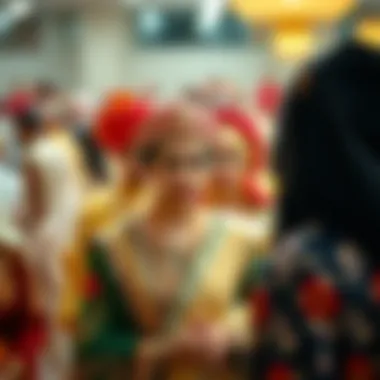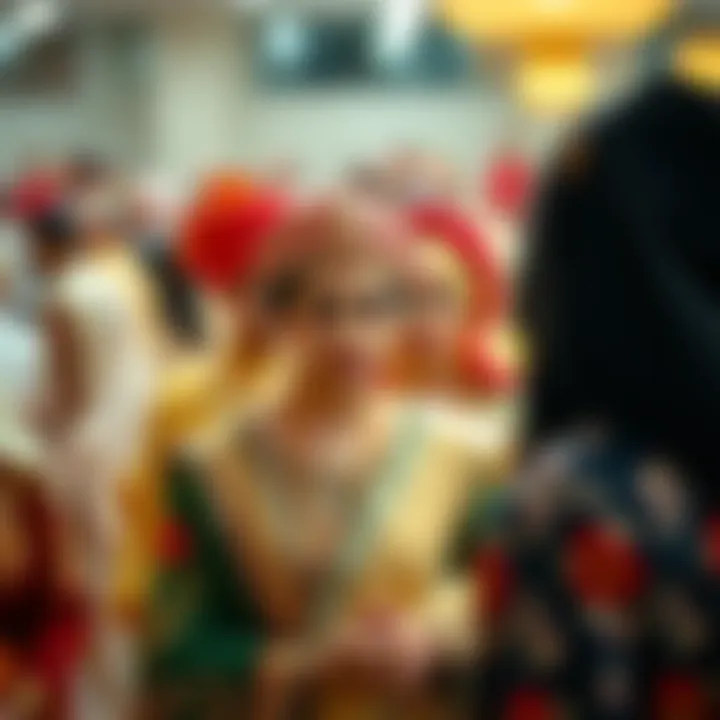Dress Code in Dubai: Cultural Insights and Expectations


Intro
Dubai stands as a unique emblem where the past and the present coexist harmoniously. It’s not just a bustling metropolis known for its skyscrapers and luxury, but a city imbued with a rich culture and a vibrant history. As travelers and residents navigate this fascinating landscape, understanding the local dress code becomes essential.
The way you present yourself in Dubai is deeply intertwined with the customs and values of its society. It goes beyond mere fabric; it’s about respecting the cultural nuances that define this locality. What might be acceptable in other cities could be seen differently in Dubai. Thus, knowing how to dress appropriately is critical—not only to align with local expectations but also to show respect for the traditions that the people hold dear.
In this guide, we delve into various facets of Dubai's dress code, across different contexts such as workplaces, public events, and cultural occasions. Furthermore, we will analyze the styles that blend modernity with the essence of tradition, ensuring that one’s personal flair does not clash with cultural sensibilities. Residents and visitors alike can benefit from this understanding, as it facilitates a smoother interaction with the community.
With a thoughtful approach, we will outline the expectations that come with each scenario while highlighting how individuals can showcase their identity within the boundaries of local decorum.
By the end of the article, readers will be well-versed in dressing appropriately for Dubai, empowering them to navigate the nuances of this vibrant city with confidence and style.
Foreword to Dress Code in Dubai
Dubai is a city where tradition and modernity coexist harmoniously. As such, understanding the dress code in this unique environment is essential for both residents and visitors. Attire isn’t merely a reflection of personal style; it also signifies respect for local customs and sensitivity towards cultural norms. Those who value the significance of dressing appropriately tend to navigate social situations more smoothly, communicate their understanding of the culture, and ultimately foster goodwill.
One thing to keep in mind is that Dubai serves as a melting pot, attracting individuals from a myriad of cultural backgrounds. While there are some universal sartorial choices, each group brings unique influences to the table. Thus, learning the ropes of what to wear can be more complex than it first looks. This section will provide a cursory glance into the relevance of adhering to the dress code in Dubai, emphasizing its benefits and considerations.
When you dress suitably, you're not only following rules but also embracing the essence of the city. Here are some important points to consider:
- Cultural Sensitivity: The UAE has a conservative background where modesty holds significance. Ensuring that your attire aligns with local customs can help avoid unintentional disrespect.
- Professionalism: In the business realm, attire plays a large role in forging relationships. Dressing appropriately in a workplace can influence perceptions, indicating your seriousness and commitment.
- Social Dynamics: Attire can dictate how you are received in various social scenarios. From formal events to casual meet-ups, the way you present yourself can leave a lasting impression.
- Weather Considerations: The desert climate can be unforgiving. Having an understanding of suitable clothing can enhance comfort, making your experience much more enjoyable.
Taking all this into account, navigating the dress code in Dubai does not require navigating treacherous waters. Instead, it's an opportunity to showcase personal style while respecting traditions that are deeply ingrained in society. The following sections will delve deeper into the historical, modern, and situational aspects of dressing in Dubai, ensuring that you are well-prepared for various environments.
Cultural Context of Dress in Dubai
Understanding the cultural context of dress in Dubai is crucial for anyone navigating this vibrant city. Dress codes are not just about fashion; they reflect the values, beliefs, and traditions that are deeply rooted in Emirati society. The attitudes towards clothing often symbolize respect for the local customs and the people who inhabit this unique place. From the flowing abayas draped over Emirati women to tailored suits in the corporate world, every outfit tells a story of its own.
Being mindful of this context not only helps in blending seamlessly into the local environment but also in fostering connections with Emiratis and visitors alike. It’s a way of saying you appreciate the culture, which can lead to more authentic interactions. A thoughtless attire can sometimes send unintended signals, and understanding the underlying significance of different clothing styles can prevent potential faux pas.
Moreover, Dress code choices often have practical implications, especially given the region's climate. This aspect becomes important for visitors not used to the heat and requires insights into breathable materials as well as appropriate layering to cope with the extreme temperature variations between indoor and outdoor settings.
"Dress is an ocean of culture where every attire is a wave reflecting local customs."
In overview, by grasping the cultural context of dress in Dubai, one not only respects local traditions but also engages in richer social exchanges. It's about more than just following rules; it's also about appreciating a way of life that is both modern and steeped in history.
Historical Influences on Dress Code
The roots of Dubai’s dress code are intertwined with its historical tapestry. Traditionally, the attire of the Emirati people was dictated by their environment and lifestyle. For centuries, the Bedouin tribes adapted their clothing to the harsh desert climate, favoring materials that offered protection and comfort in high temperatures and sandstorms. The kandura, a long white robe worn by men, efficiently reflects sunlight, keeping its wearer cooler during the hot summer months, while the abaya, a loose-fitting black cloak for women, ensures modesty and adherence to cultural norms.
As Dubai transitioned from a trading hub to a modern metropolis, the influx of international businessmen and tourists began to influence local dress. The introduction of Western fashion elements gradually found their way into the wardrobes of residents. This blending of styles has resulted in a rich tapestry of influences, reflecting both the region's heritage and its aspirations toward modernity.
Modern Influences: A Fusion of East and West
In today’s Dubai, one can observe a vibrant fusion of styles that highlight the city’s progressive and diverse nature. The modern Emirati, especially the youth, are increasingly adopting global fashion trends while retaining elements that speak to their cultural heritage. This can be seen in the evolution of the kandura and abaya, which now come in various colors and trendy designs, displaying artistic flair while still upholding traditional values.
Moreover, luxury brands and designer boutiques flourish alongside traditional souks, showcasing a wide array that caters to every taste. While Western-style business attire prevails in professional settings, casual outings allow for a mix of international styles in restaurants and malls. However, discretion still plays a significant role, reflecting respect for local customs. For visitors, dressing in a way that appreciates both modernity and tradition can enhance their experience and foster a deeper understanding of Dubai’s unique cultural landscape.


By recognizing these modern influences, one can effortlessly navigate the complex dress codes of Dubai, expressing personal style without overshadowing the sense of place and tradition that defines the city.
General Guidelines for Visitors
Understanding the dress code in Dubai is crucial for anyone planning to visit or reside in this vibrant city. The guidelines aren’t just about fashion; they reflect a deep respect for local customs and traditions. In a place that intertwines modernity with rich cultural heritage, wearing the right attire can speak volumes about one’s appreciation for this uniqueness. This section offers a roadmap for visitors, providing essential tips to navigate the varied social landscapes and ensuring that everyone feels comfortable and accepted.
Appropriate Attire in Public Spaces
Navigating public spaces in Dubai requires some consideration regarding attire. While the city buzzes with multicultural energy, it’s vital to remember that public areas often demand a more modest approach to clothing.
Wearing clothing that covers the shoulders and knees is generally expected. For men, this usually means avoiding shorts in favor of trousers, which helps in respecting the local culture. Women might find long dresses or skirts coupled with lightweight, long-sleeved tops more suitable. Not only does this blend well into the environment, but it also shields against the heat of the day.
Here are some key points to consider:
- Materials: Opt for breathable fabrics like cotton or linen to combat the heat.
- Footwear: While sandals are common, closed shoes are preferred in certain areas.
- Swimwear: Reserve swimsuits for beaches or pool areas only; wearing them outside such designated zones is frowned upon.
This approach fosters mutual respect and can make your interactions with locals more pleasant.
Taking these simple steps can significantly impact how visitors are perceived and received. Dressing appropriately shows an understanding of local customs and can enrich one’s experience in this cosmopolitan hub.
Respecting Local Traditions in Clothing Choices
Clothes carry significant cultural weight, especially in a city like Dubai, steeped in traditions. Embracing local dress traditions can serve not only to avoid any faux pas but also provide insight into the rich heritage that shapes Dubai's identity.
For visitors, it means being mindful of the cultural context surrounding clothing. For example, both men and women may benefit from understanding the significance behind traditional garments like the kandura for men or the abaya for women. Wearing these during festivals or cultural events demonstrates an eagerness to engage with local customs, and it enriches the visitor's experience.
A few tips include:
- Observe and Adapt: Pay attention to local customs, observing how residents dress in various contexts. This can offer clues on appropriateness.
- Opting for Symbolic Colors: During certain occasions like Ramadan, wearing specific colors can show solidarity with local customs. For example, muted tones are often preferred during this holy month.
- Avoid Provocative or Offensive Imagery: Graphics that may be acceptable in some cultures might not resonate well here. It’s prudent to keep clothing choices understated and respectful.
By respecting these traditions, visitors cultivate not just respect but also curiosity about the local culture, creating an enriched travel experience while ensuring they’re dressing in a socially conscious manner.
Dress Code for Specific Settings
Understanding the dress code for various settings in Dubai is vital for anyone planning to visit or live in the emirate. The blend of Islamic tradition and modern influences means that appropriate attire can vary greatly depending on the occasion. This knowledge not only shows respect for local customs but also helps avoid awkward situations that may arise from misunderstandings about what is deemed acceptable.
Workplace Attire Expectations
Dressing appropriately for the workplace in Dubai cannot be understated. It establishes professionalism and respect for the organizational culture. Generally, the corporate atmosphere tends to lean towards conservative styles. Men often don tailored suits or dress shirts, and women might find that smart blouses paired with skirts or trousers are common. Particularly, industries like finance or law might expect stricter adherence to formal attire than sectors such as creative arts or technology, where there might be more flexibility.
When choosing fabrics, seek breathable options, as the humid climate can be challenging during the hotter months. Avoiding overly casual attire like jeans or sandals in these settings is crucial. Often, companies might have specific guidelines; it's prudent to consult co-workers or the HR department to ensure you are on point with the standards set by the organization.
Formal Events and Their Attire Norms
In Dubai, formal events can range from business functions to extravagant weddings, each with its own set of dress standards. Men are usually expected to wear dark suits or traditional outfits known as kandura, while women often wear elegant formal dresses or abayas, which are long flowing garments that can still allow for personal style without crossing cultural boundaries.
"Adorning yourself for a formal event is not just about fashion; it signifies respect for the occasion and its hosts."


For those invited to events during the evening, it’s wise to consider darker colors, as they tend to reflect the formality of the event more effectively. On the other hand, daytime formal gatherings might allow for lighter hues, yet the emphasis on elegance remains the same. Always keep in mind, it's the subtle details and accessories that can elevate an outfit to fit the occasion.
Casual Outings: Do's and Don'ts
When it comes to casual outings, Dubai offers a colorful tapestry of opportunities to explore, but choosing what to wear can be a bit of a balancing act. Here are some important do's and don'ts to guide your wardrobe choices:
Do's:
- Opt for Breathable Fabrics: Light cottons or linens can keep you cool in the heat.
- Embrace Modesty: While the city is modern, it still values modest attire. Aim for knee-length shorts or skirts and tops with sleeves.
- Dress for the Venue: Be mindful of where you’re going. Street markets and casual dining spots might require more relaxed attire than shopping in high-end malls.
Don'ts:
- Avoid Revelatory Clothing: Sticking to conservative dress styles helps in not attracting unwanted attention and showcases respect for the locale.
- Skip the Beachwear Away from the Beach: Swimwear is best left for the pool or beach. Wearing it elsewhere can be viewed as inappropriate.
- Say No to Offensive Graphics or Words: Clothing with provocative slogans or images should be avoided.
Finding the right balance between comfort and cultural sensitivity in Dubai will greatly enhance experiences. With a little thought about what to wear, one can enjoy all the city has to offer while respecting its rich cultural fabric.
Special Events and Festivals
Special events and festivals serve as pivotal moments in the cultural calendar of Dubai, showcasing the rich tapestry of traditions and values that shape the city. These occasions not only bring communities together but also present unique opportunities for visitors to engage with local customs. Understanding the dress codes associated with these festivities is vital, as they reflect both respect for traditions and an appreciation for the cultural significance behind them.
Dress Code for Ramadan
Ramadan is a sacred month for Muslims around the world, including the residents of Dubai. During this time, the city transforms into a reflective space, emphasizing spirituality and community. The dress code during Ramadan tends to lean towards modesty, and it’s customary to wear loose-fitting garments that cover the shoulders and knees. Men might opt for traditional dishdashas or lightweight shirts paired with tailored trousers, while women often wear abayas, which are both stylish and respectful.
In public spaces, it's essential to adhere to these guidelines, especially as many locals are fasting and observing the spirit of the month. The right attire can reflect a sense of solidarity and respect towards their practices, making it a delightful learning experience for travelers not familiar with Islamic traditions. Avoiding overly tight or revealing clothing during this period exhibits understanding and respect for the cultural norms in place.
Attire for National Day Celebrations
National Day is a time of pride for Emiratis, celebrated with grand festivities that bring together family and friends. This event, marked on December 2nd, showcases the unity and heritage of the United Arab Emirates. On this day, attire plays a symbolical role. Many people choose to wear the national colors of red, green, white, and black, showcasing their patriotic spirit.
For men, this might mean wearing a kandora decorated with these colors, while women often incorporate them into their traditional dress or accessories. Festive events include parades and fireworks, so attendees commonly opt for comfortable footwear and breathable fabrics to enjoy the outdoor celebrations fully. Bright colors and traditional patterns are popular, making for a visually vibrant atmosphere.
For visitors participating in National Day celebrations, joining in with appropriate dress displays a willingness to engage with the culture. Attending festivities without embracing the local attire may come off as insensitivity, thus showing enthusiasm through clothing choices can deepen the overall experience while paying homage to the local customs.
"Dressing thoughtfully during special events and festivals is more than mere appearance; it’s a heartfelt acknowledgment of the local customs that bind the diverse tapestry of Dubai together."
Clothing Materials and Weather Considerations
When dressing for Dubai, it's not only about the style but also the materials you choose. The city’s climate is characterized by high temperatures and humidity, especially during the summer months. Understanding the right clothing materials can significantly enhance comfort while also aligning with cultural expectations.
Selecting appropriate fabrics is vital. Breathable textiles allow air to circulate, helping to keep the body cool. Cotton, linen, and moisture-wicking synthetics are some of the best choices. Such materials help in avoiding discomfort and other potential issues like heat exhaustion, which can occur in the sweltering heat that Dubai often presents.
Choosing Breathable Fabrics
In Dubai’s intense heat, lightweight and breathable fabrics become your best friends.
- Cotton: Soft and absorbent, it's ideal for casual wear. It allows sweat to evaporate, making it a preferred choice for everyday attire.
- Linen: This fabric is even more breathable than cotton. Its natural fibers provide an airy feel, perfect for both men’s and women’s clothing. However, keep in mind that linen can wrinkle easily, which might not be suitable for formal occasions.
- Moisture-Wicking Synthetics: Fabrics like polyester or blends that include spandex can effectively draw moisture away from the body. This is particularly beneficial during outdoor activities or long days spent walking around the city.


Ensuring that you prioritize these materials in your wardrobe can be a game changer in how you feel while navigating the bustling streets or glitzy malls of Dubai. The balance of comfort and style can undoubtedly be achieved with the right fabric choices.
Layering for Indoor and Outdoor Settings
Dubai's weather is notably inconsistent between indoor and outdoor environments. While the sun beats down mercilessly outside, the interiors of buildings, such as shopping malls and restaurants, are often air-conditioned. Thus, layering becomes a practical strategy.
- Lightweight Cardigans or Shawls: While it may be hot outside, these can be easily tossed on in air-conditioned spaces. They provide an additional layer without becoming overly cumbersome.
- Collared Shirts or Blouses: When worn underneath jackets, these can keep the look polished while allowing for easy removal once you're outside.
- Pashminas or Scarves: These can be particularly useful for women. They can serve as a light covering for the shoulders when entering more conservative spaces, plus they are easy to carry for those temperature transitions.
Overall, being mindful of fabric choices and layering can ensure that you stay comfortable and respectful of local customs. While you certainly don't want to feel like a walking sauna, it’s equally important to dress appropriately for the varied environments you will encounter in Dubai.
Missteps to Avoid
Navigating the dress code in a culturally rich place like Dubai can be a bit of a minefield for newcomers and even long-time residents. Understanding what not to do can save a lot of embarrassment and even potential conflict, making it paramount for anyone wishing to blend in respectfully. This section outlines some typical missteps that visitors and residents alike should avoid in their clothing choices. Keeping in mind the importance of attire in this multicultural hub not only reflects respect for local customs but also demonstrates a commitment to harmony in an increasingly interconnected world.
Common Fashion Faux Pas
When it comes to dressing in Dubai, seemingly harmless decisions can sometimes turn out to be ill-advised. Here are a few fashion do's and don’ts that can make or break your experience:
- Overly Revealing Clothing: While the hot weather might tempt one to wear shorts and tank tops, this is not always appropriate outside of beach areas or private pools. Dress codes are not just a guideline; they signify an acknowledgment of cultural sensitivities.
- Slogan Tees and Provocative Images: Wearing clothing with offensive or explicit slogans is best avoided. Not only can this come across as disrespectful, but it may also attract unwanted attention from authorities.
- Beachwear in Public Spaces: It's all too easy to slip into beach attire after a day at the shore. However, strutting around in swimwear while shopping in malls or dining in restaurants can be frowned upon.
- Flip-Flops and Sportswear: Although Dubai has a laid-back vibe, wearing flip-flops or heavy sportswear at upscale venues is a big no-no. Make sure your shoes fit the occasion, especially in fine dining restaurants or high-end establishments.
Key Point: Dress thoughtfully to avoid social faux pas. A little effort can go a long way in fostering goodwill and respect.
Cultural Insensitivity in Dress Choices
Being sophisticated in your choice of attire goes hand-in-hand with cultural awareness. Failing to consider the implications of your clothing can lead to misunderstandings:
- Traditional Attire Misunderstanding: Many visitors might not grasp the significance of traditional Emirati dress, such as the kandura or abaya. Wearing these outfits without understanding their meanings can be perceived as mockery, rather than respect.
- Inappropriate Footwear: Worn-out or inappropriate footwear can draw eyes for the wrong reasons. In many places, particularly when visiting mosques or high-end hotels, presenting oneself neatly is vital to showing respect.
- Ignoring Religious Events: During significant times, such as Ramadan, it’s imperative to dress more conservatively. Ignoring such nuances can be seen as deeply insensitive.
"A well-chosen outfit can build bridges, while a thoughtless one might put up walls."
By staying informed and avoiding these missteps, you’ll not only feel more comfortable in Dubai but will also cultivate an atmosphere of mutual respect wherever you go. Remember, what you wear is often a reflection of your understanding of the world around you.
Ending: The Importance of Dressing Thoughtfully in Dubai
Dressing in Dubai is not just a matter of aesthetics; it’s woven deeply into the cultural fabric of the city. The blend of traditional values and modern influences creates a unique tapestry where attire carries significant weight. When understanding why thoughtful dressing is crucial, several specific elements come into play.
Firstly, it's essential to recognize that attire serves as a reflection of respect for local customs. Dubai, as part of the United Arab Emirates, upholds Islamic principles, which often dictate modesty in clothing. By choosing outfits that adhere to these principles, individuals signal their understanding and appreciation of the region's cultural norms. It’s like walking into someone’s home and respecting their rules—doing so fosters goodwill and helps to establish rapport.
Secondly, the perception of professionalism varies greatly across different cultures. In workplaces throughout Dubai, being appropriately attired can influence how one is viewed by colleagues and superiors. A tailored suit might resonate well in a business setting, while casual clothing can be seen as unprofessional. As such, dressing thoughtfully can have a direct impact on one’s career trajectory.
It's also worth highlighting the importance of dressing for specific occasions, which can range from formal events to casual outings. Each event comes with its own set of expectations. For instance, during Ramadan, which is observed with a heightened sense of spirituality and reflection, conservative dressing shows solidarity with local traditions. On the other hand, events such as National Day may invite a sense of pride and celebration, which might allow for more festive attire.
Furthermore, the climatic aspects of Dubai can’t be ignored when discussing attire. The weather tends to be quite hot, and selecting breathable fabrics can enhance comfort without compromising style. Wearing light materials becomes not just practical but also a part of the ensemble’s aesthetic appeal.
A few guidelines to remember include:
- Select breathable fabrics such as cotton and linen for warmer months.
- Be mindful of cultural gatherings, and align your clothing choices with local expectations.
- Respect those around you by avoiding overly revealing attire in public spaces.
Ultimately, dressing thoughtfully in Dubai enriches the experience of living or visiting the city. It cultivates awareness and respect for its rich heritage while allowing individuals to express their unique style within those parameters. In turn, this approach creates a harmonious blend of local culture and personal expression.
"In many ways, how we dress defines us, influencing not only perceptions but also interactions with others."
By embracing the nuances of dress in Dubai, individuals become more than just visitors; they become part of a vibrant tapestry that celebrates both cultural identity and modern expression. Moving forward, navigating the intricate dance of tradition and style is vital for anyone wishing to thrive in this dynamic part of the world.















